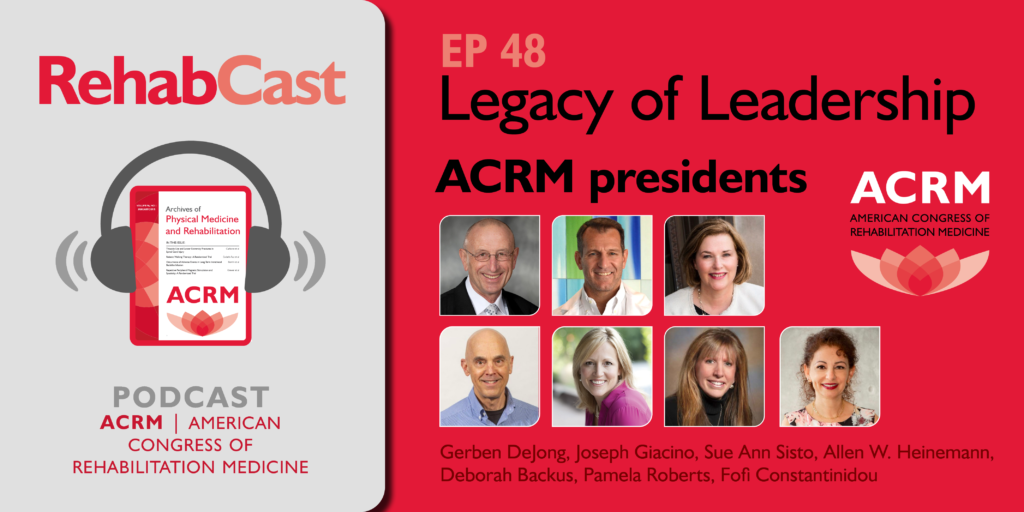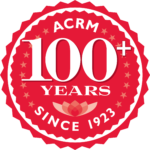
ACRM celebrated its centennial conference in Atlanta 2023 in a big way:
- 100th exhibit with 50-foot historical timeline
- ACRM documentary series
- ACRM Presidents honor wall
- 100th lapel pins for all
- SPECIAL Plenary session by ACRM Presidents past & future
- 100th silver spoons given to ACRM presidents following the tradition from the ACRM 50th
SPECIAL PLENARY session
From Gatsby to ChatGPT: How ACRM Shaped Rehabilitation over the Last Century
ACRM presidents shared their unique perspectives on the influential role of ACRM in shaping the evolution of rehabilitation — transcending decades of societal, technological, and cultural change and significant impacts on the rehabilitation community.
ACRM Centenial Story
Legacy of Leadership
ACRM Presidents
In the 48th episode of the #RehabCast listen to host, Dr. Bill Niehaus, as he engages in captivating conversations with esteemed members of ACRM. Together, they explore the remarkable journey of the rehabilitation field and the American Congress of Rehabilitation Medicine. As the 100th ACRM Annual FALL Conference is celebrated, tune in and hear insights from ACRM presidents:
ACRM Timeline
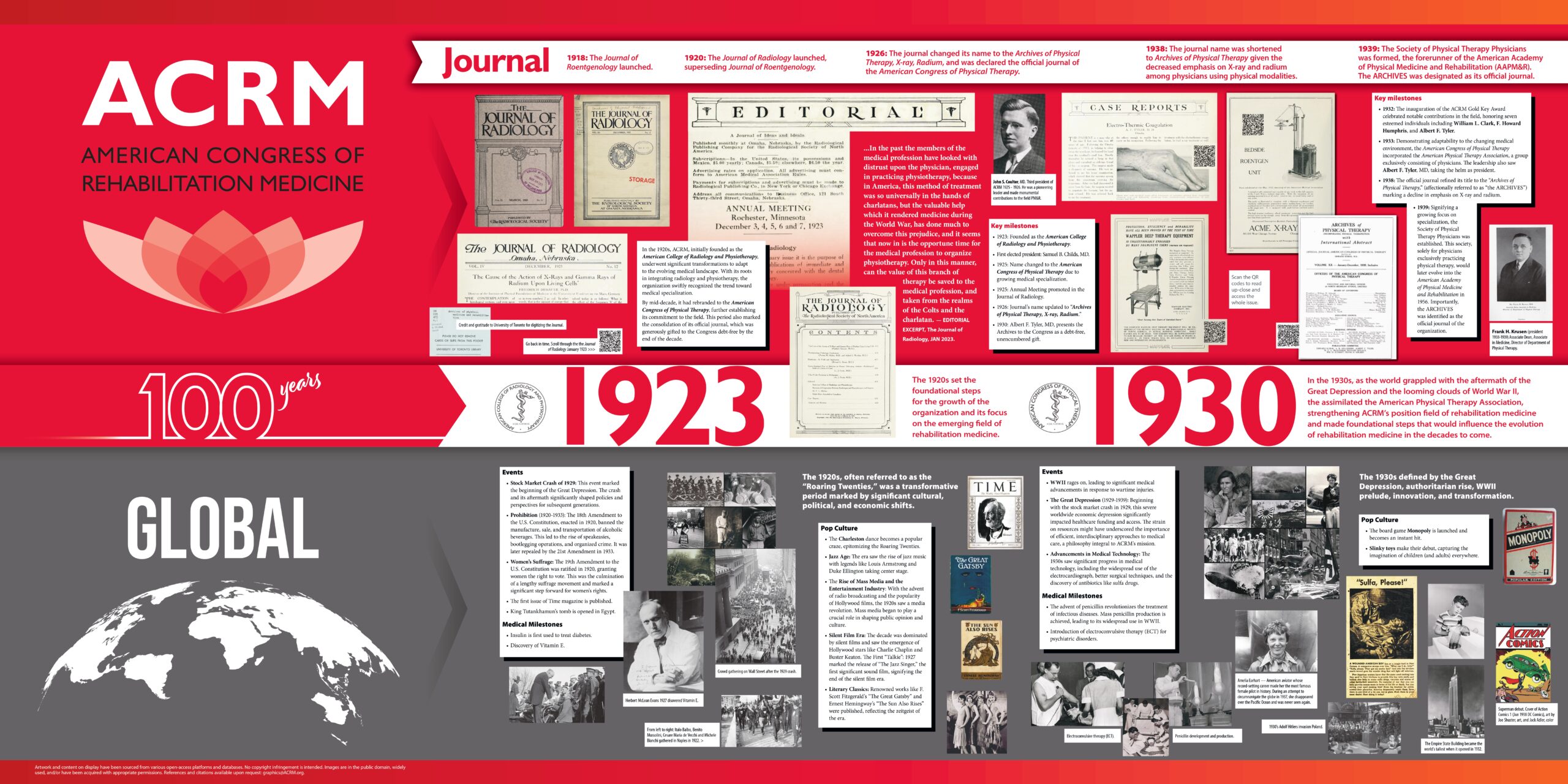
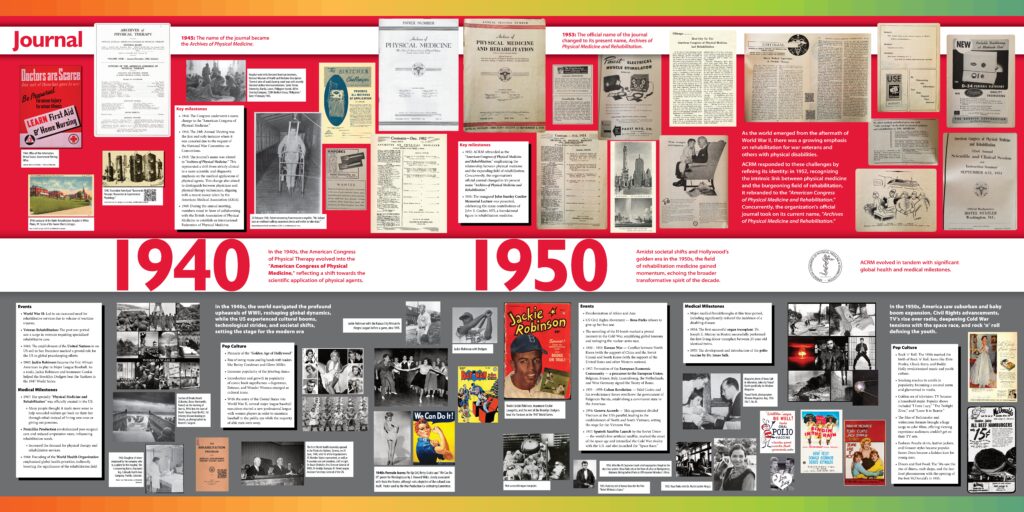
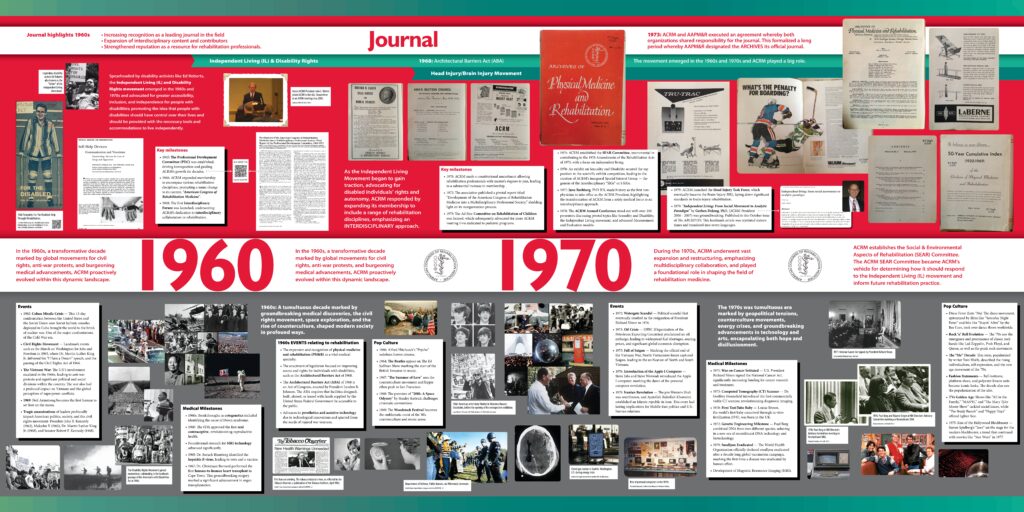
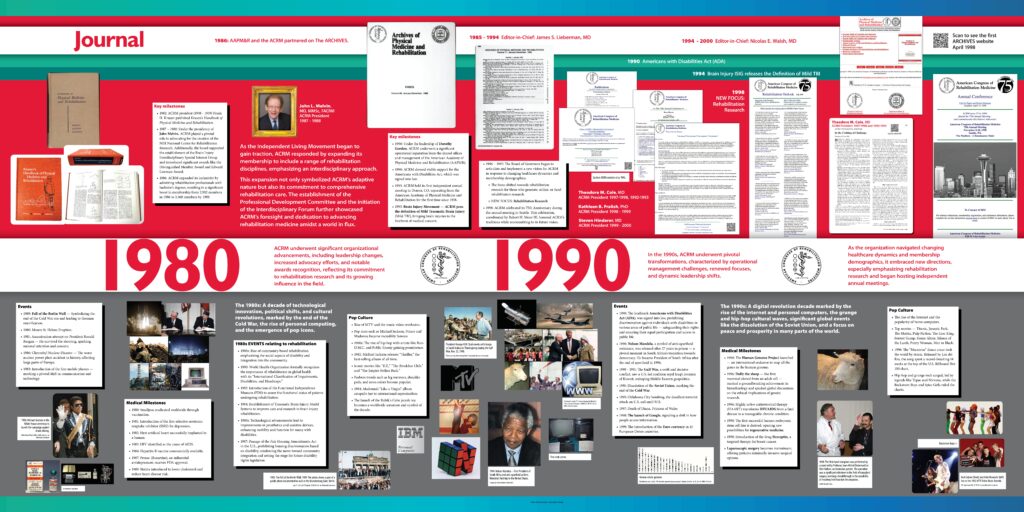
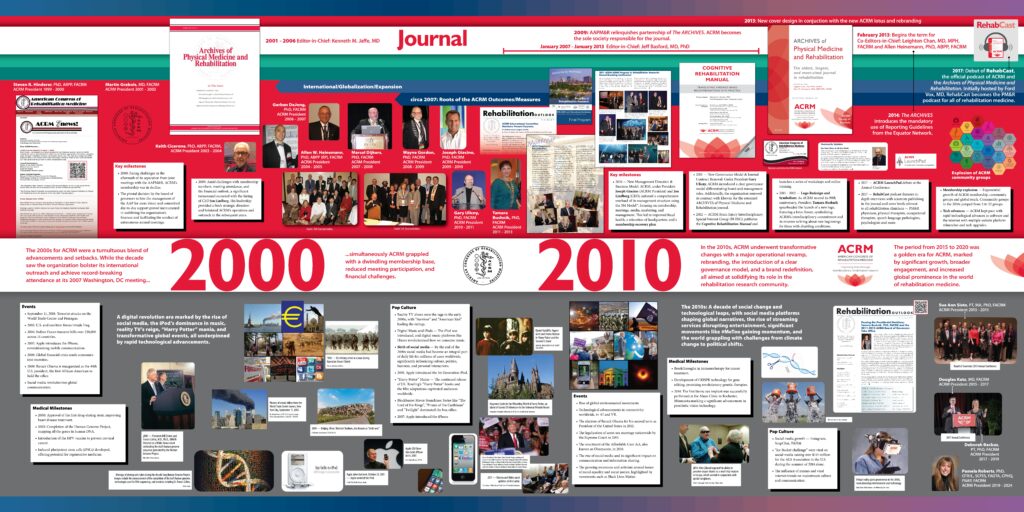

ACRM-only key events
1923
Founded as the American College of Radiology and Physiotherapy.
1925
Name changed to the American Congress of Physical Therapy due to growing medical specialization.
1925
Annual Meeting promoted in the Journal of Radiology.
1926
Journal’s name updated to “Archives of Physical Therapy, X-ray, Radium.”
1930
Albert F. Tyler, MD, presents the Archives to the Congress as a debt-free, unencumbered gift.
1932
The inauguration of the ACRM Gold Key Award celebrated notable contributions in the field, honoring seven esteemed individuals including William L. Clark, F. Howard Humphris, and Albert F. Tyler.
1933
Demonstrating adaptability to the changing medical environment, the American Congress of Physical Therapy incorporated the American Physical Therapy Association, a group exclusively consisting of physicians. The leadership also saw Albert F. Tyler, MD, taking the helm as president.
1938
The official journal refined its title to the “Archives of Physical Therapy,” (affectionally referred to as “the ARCHIVES”) marking a decline in emphasis on X-ray and radium.
1939
Signifying a growing focus on specialization, the Society of Physical Therapy Physicians was established. This society, solely for physicians exclusively practicing physical therapy, would later evolve into the American Academy of Physical Medicine and Rehabilitation in 1956. Importantly, the ARCHIVES was identified as the official journal of the organization.
1944
The Congress underwent a name change to the “American Congress of Physical Medicine.”
1945
The 24th Annual Meeting was the first and only instance where it was canceled due to the request of the National War Committee on Conventions.
1945
The journal’s name became “Archives of Physical Medicine.” This aimed to distinguish between physicians and physical therapy technicians, a stance taken by the American Medical Association (AMA).
1949
During the annual meeting, members voted in favor of collaborating with the British Association of Physical Medicine to establish an International Federation of Physical Medicine.
1951
The inaugural John Stanley Coulter Memorial Lecture was presented, celebrating the many contributions of John S. Coulter, MD, a foundational figure in rehabilitation medicine.
1952
ACRM rebranded as the “American Congress of Physical Medicine and Rehabilitation,” emphasizing the relationship between physical medicine and the expanding field of rehabilitation.
1953
The organization’s official journal changed to it’s present name “Archives of Physical Medicine and Rehabilitation.”
1965
The Professional Development Committee (PDC) was established, driving introspection and guiding ACRM’s growth for decades.
1966
ACRM expanded membership to encompass various rehabilitation disciplines, prompting a name change to its current, “American Congress of Rehabilitation Medicine”.
1968
The first Interdisciplinary Forum was launched, underscoring ACRM’s dedication to interdisciplinary collaboration in rehabilitation.
1970
ACRM made a constitutional amendment allowing rehabilitation professionals with master’s degrees to join, leading to a substantial increase in membership.
1972
The association published a pivotal report titled “Development of the American Congress of Rehabilitation Medicine into a Multidisciplinary Professional Society,” shedding light on its reorganization process.
1973
The Ad Hoc Committee on Rehabilitation of Children was formed, which subsequently advocated for more ACRM meeting time dedicated to pediatric programs.
1975
ACRM established the SEAR Committee, instrumental in contributing to the 1978 Amendments of the Rehabilitation Acts of 1973, with a focus on independent living.
1976
An exhibit on Sexuality and Disability secured the top position in the scientific exhibit competition, leading to the creation of ACRM’s inaugural Special Interest Group — the genesis of the Interdisciplinary “SIGs” or I-SIGs.
1977
June Rothberg, PhD RN, made history as the first nonphysician to take office as the ACRM President, highlighting the transformation of ACRM from a solely medical focus to an interdisciplinary approach.
1978
The ACRM Annual Conference stood out with over 350 presenters discussing pivotal topics like Sexuality and Disability, the Independent Living movement, and advanced Measurement and Evaluation models.
1979
ACRM launched the Head Injury Task Force, which eventually became the Brain Injury ISIG, laying down significant standards in brain injury rehabilitation.
1979
“Independent Living: From Social Movement to Analytic Paradigm” by Gerben DeJong, PhD, (ACRM President 2006 - 2007) was groundbreaking. Published in the October issue of The ARCHIVES. This landmark article was reprinted sixteen times and translated into seven languages.
1982
ACRM president (1938 - 1939) Frank H. Krusen published Krusen’s Handbook of Physical Medicine and Rehabilitation.
1986
ACRM expanded its inclusivity by admitting rehabilitation professionals with bachelor’s degrees, resulting in a significant boost in membership from 2,902 members in 1986 to 3,360 members by 1989.
1987–1988
1988: Under the presidency of John Melvin, ACRM played a pivotal role in advocating for the creation of the NIH National Center for Rehabilitation Research. Additionally, the board supported the establishment of the Brain Injury Interdisciplinary Special Interest Group and introduced significant awards like the Distinguished Member Award and Edward Lowman Award.
1990
Under the leadership of Dorothy Gordon, ACRM underwent a significant operational separation from the shared offices and management of the American Academy of Physical Medicine and Rehabilitation (AAPMR).
1990
ACRM showed visible support for the Americans with Disabilities Act, which was signed into law.
1993
ACRM held its first independent annual meeting in Denver, CO, separating from the American Academy of Physical Medicine and Rehabilitation for the first time since 1938.
1993
Brain Injury Movement — ACRM pens the definition of Mild Traumatic Brain Injury (Mild TBI), bringing brain injuries to the forefront of medical concern.
1996–1997
The Board of Governors began to articulate and implement a new vision for ACRM in response to changing healthcare dynamics and membership demographics.
»The focus shifted towards rehabilitation research for those who generate, utilize, or fund rehabilitation research.
»NEW FOCUS: Rehabilitation Research
1998
ACRM celebrated its 75th Anniversary during the annual meeting in Seattle. This celebration, coordinated by Robert H. Meier III, honored ACRM’s traditions while recommitting to its future vision.
2000
Facing challenges in the aftermath of its separation from joint meetings with the AAPM&R, ACRM’s membership was in decline.
2009
Amid challenges with membership numbers, meeting attendance, and the financial outlook, a significant turnaround occurred with the hiring of CEO Jon Lindberg. His leadership provided a fresh strategic direction and bolstered ACRM’s operations and outreach in the subsequent years.
2010
New Management Direction & Business Model: ACRM, under President Joseph Giacino (ACRM President) and Jon Lindberg (CEO), initiated a comprehensive overhaul of its management structure using the 5M Model™, focusing on membership, meetings, media, marketing, and management. This led to improved fiscal health, a relocation of headquarters, and a membership recovery plan.
2011
New Governance Model & Journal Contract Renewal: Under President Gary Ulicny, ACRM introduced a clear governance model differentiating board and management roles. Additionally, the organization renewed its contract with Elsevier for the esteemed ARCHIVES of Physical Medicine and Rehabilitation journal.
2012
ACRM Brain Injury Interdisciplinary Special Interest Group (BI-ISIG) publishes the Cognitive Rehabilitation Manual and launches a series of workshops and online training.
2011–2013
Logo Redesign and Symbolism: As ACRM neared its 90th anniversary, President Tamara Bushnik spearheaded the launch of a new logo, featuring a lotus flower, symbolizing ACRM’s interdisciplinary commitment and its mission to bring about new beginnings for those with disabling conditions.
2017
ACRM LaunchPad debuts at the Annual Conference
2017
RehabCast podcast features indepth interviews with scientists publishing in the journal and news briefs relevant to all rehabilitation clinicians — PM&R physicians, physical therapists, occupational therapists, speech-language pathologists, psychologists and more.
2022
ACRM Brain Injury Interdisciplinary Special Interest Group (BI-ISIG) publishes the ACRM Brain Injury Interdisciplinary Special Interest Group (BI-ISIG) publishes the Cognitive Rehabilitation Manual —Manual & Textbook — SECOND EDITION complete with robust campanion website and updated online course and in-person workshops.
2023
ACRM holds their 100th Annual Conference in Atlanta.
HELP MAKE THIS BETTER
Please submit your materials — words, photos, vid clips — for future iterations and to enrich the history of ACRM.
Join the ACRM centennial celebration by sharing your valuable stories, images, and video clips.
Your submissions will help shape the future and enrich the rich history of ACRM.
Let your voice be heard, and contribute to our legacy.
Please submit your materials — words, photos, vid clips — to enrich the history of ACRM.
TIP: please include the caption information; who is pictured. Place this info in the file name itself or separately
- By submitting your materials, you agree to allow ACRM to use your content for public display, including but not limited to ACRM marketing materials, web pages, emails, and social media. Your contribution will be credited appropriately.
- Please ensure you have the necessary rights to share the submitted content and that it does not infringe upon any third-party rights. ACRM reserves the right to edit or modify submissions for clarity or length if necessary.

